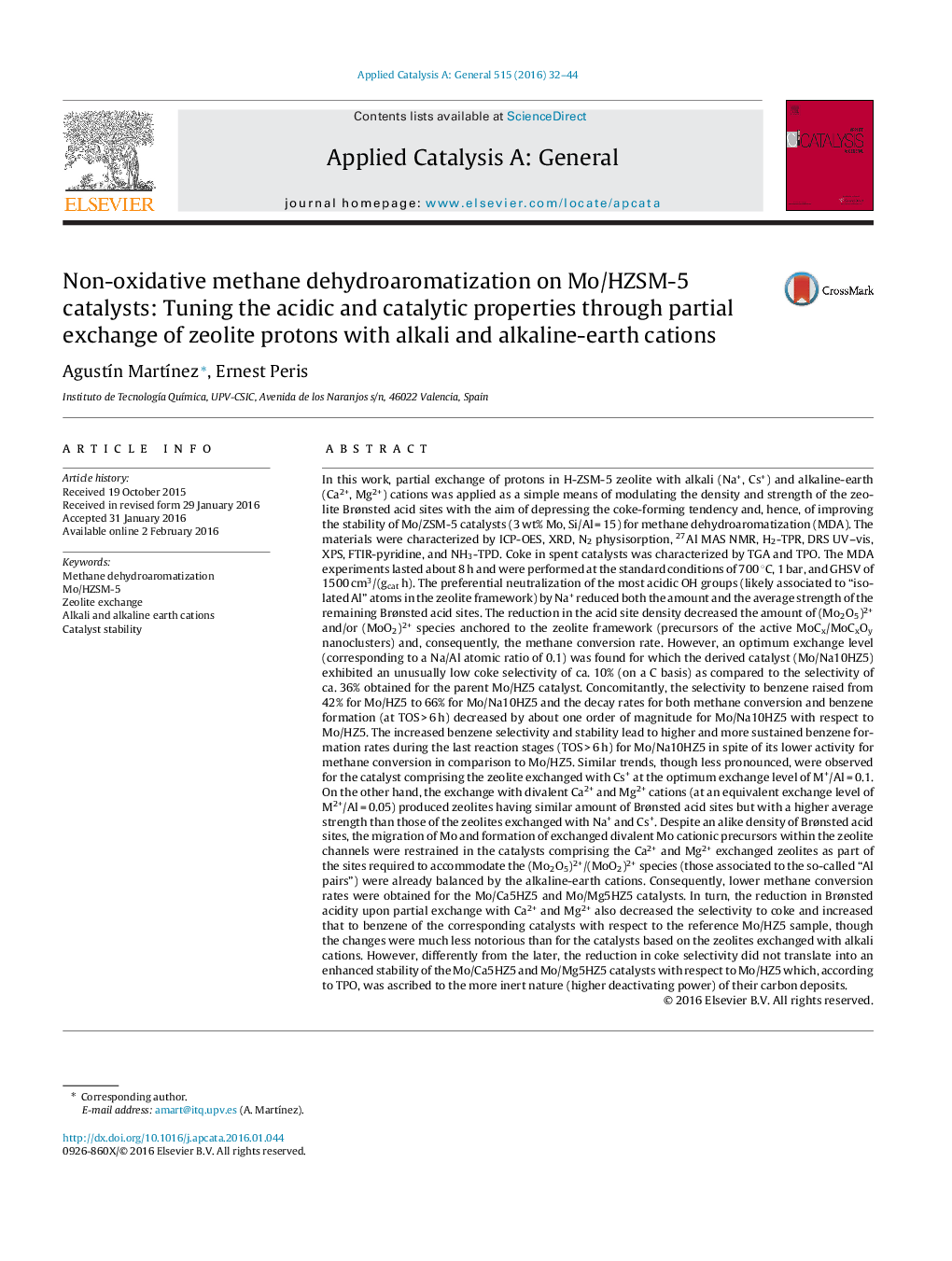| کد مقاله | کد نشریه | سال انتشار | مقاله انگلیسی | نسخه تمام متن |
|---|---|---|---|---|
| 38860 | 45794 | 2016 | 13 صفحه PDF | دانلود رایگان |

• Partial exchange of H+ in HZSM-5 with Na+/Cs+ decreases coking and improves benzene selectivity and stability for MDA.
• Partial exchange with Ca2+/Mg2+ inhibits migration of Mo within the zeolite channels and worsens MDA performance.
• Framework “Al pairs” play a key role for optimizing the catalytic performance of Mo/HZSM-5 catalysts for MDA.
In this work, partial exchange of protons in H-ZSM-5 zeolite with alkali (Na+, Cs+) and alkaline-earth (Ca2+, Mg2+) cations was applied as a simple means of modulating the density and strength of the zeolite Brønsted acid sites with the aim of depressing the coke-forming tendency and, hence, of improving the stability of Mo/ZSM-5 catalysts (3 wt% Mo, Si/Al = 15) for methane dehydroaromatization (MDA). The materials were characterized by ICP-OES, XRD, N2 physisorption, 27Al MAS NMR, H2-TPR, DRS UV–vis, XPS, FTIR-pyridine, and NH3-TPD. Coke in spent catalysts was characterized by TGA and TPO. The MDA experiments lasted about 8 h and were performed at the standard conditions of 700 °C, 1 bar, and GHSV of 1500 cm3/(gcat h). The preferential neutralization of the most acidic OH groups (likely associated to “isolated Al” atoms in the zeolite framework) by Na+ reduced both the amount and the average strength of the remaining Brønsted acid sites. The reduction in the acid site density decreased the amount of (Mo2O5)2+ and/or (MoO2)2+ species anchored to the zeolite framework (precursors of the active MoCx/MoCxOy nanoclusters) and, consequently, the methane conversion rate. However, an optimum exchange level (corresponding to a Na/Al atomic ratio of 0.1) was found for which the derived catalyst (Mo/Na10HZ5) exhibited an unusually low coke selectivity of ca. 10% (on a C basis) as compared to the selectivity of ca. 36% obtained for the parent Mo/HZ5 catalyst. Concomitantly, the selectivity to benzene raised from 42% for Mo/HZ5 to 66% for Mo/Na10HZ5 and the decay rates for both methane conversion and benzene formation (at TOS > 6 h) decreased by about one order of magnitude for Mo/Na10HZ5 with respect to Mo/HZ5. The increased benzene selectivity and stability lead to higher and more sustained benzene formation rates during the last reaction stages (TOS > 6 h) for Mo/Na10HZ5 in spite of its lower activity for methane conversion in comparison to Mo/HZ5. Similar trends, though less pronounced, were observed for the catalyst comprising the zeolite exchanged with Cs+ at the optimum exchange level of M+/Al = 0.1. On the other hand, the exchange with divalent Ca2+ and Mg2+ cations (at an equivalent exchange level of M2+/Al = 0.05) produced zeolites having similar amount of Brønsted acid sites but with a higher average strength than those of the zeolites exchanged with Na+ and Cs+. Despite an alike density of Brønsted acid sites, the migration of Mo and formation of exchanged divalent Mo cationic precursors within the zeolite channels were restrained in the catalysts comprising the Ca2+ and Mg2+ exchanged zeolites as part of the sites required to accommodate the (Mo2O5)2+/(MoO2)2+ species (those associated to the so-called “Al pairs”) were already balanced by the alkaline-earth cations. Consequently, lower methane conversion rates were obtained for the Mo/Ca5HZ5 and Mo/Mg5HZ5 catalysts. In turn, the reduction in Brønsted acidity upon partial exchange with Ca2+ and Mg2+ also decreased the selectivity to coke and increased that to benzene of the corresponding catalysts with respect to the reference Mo/HZ5 sample, though the changes were much less notorious than for the catalysts based on the zeolites exchanged with alkali cations. However, differently from the later, the reduction in coke selectivity did not translate into an enhanced stability of the Mo/Ca5HZ5 and Mo/Mg5HZ5 catalysts with respect to Mo/HZ5 which, according to TPO, was ascribed to the more inert nature (higher deactivating power) of their carbon deposits.
Figure optionsDownload high-quality image (142 K)Download as PowerPoint slide
Journal: Applied Catalysis A: General - Volume 515, 10 April 2016, Pages 32–44